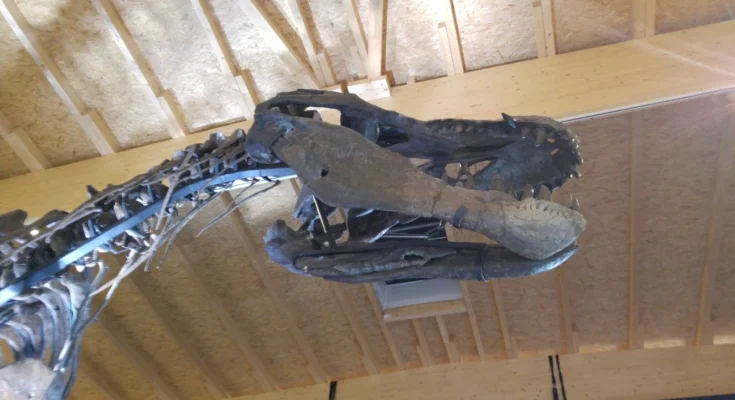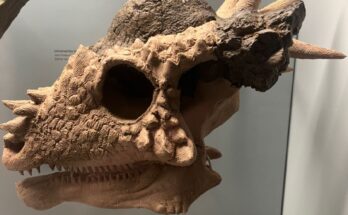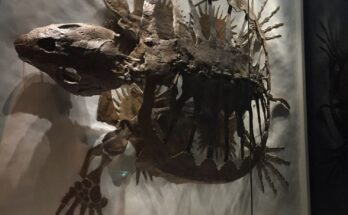Rocky: Exploring the World’s Only Original Skeleton of a Juvenile Tyrannosaurus rex – A Step-by-Step Guide to Its Discovery, Morphology, and Role in Understanding Tyrannosaurid Growth
In the fascinating field of paleontology, juvenile dinosaur specimens offer invaluable insights into growth patterns, behavior, and evolutionary adaptations that adult fossils alone cannot provide. The skeleton known as “Rocky,” a half-grown (subadult) Tyrannosaurus rex, stands out as a rare gem in this regard. Housed at the Dinosaurier Museum Altmühltal in Denkendorf, Bavaria, Germany, Rocky is promoted as the only original skeleton of a juvenile T. rex on display worldwide, and it is one of just three authentic T. rex skeletons exhibited in Europe—the sole example in Germany. This tutorial-style article will guide you through an in-depth exploration of Rocky, mirroring the analytical process paleontologists use when studying such finds. We’ll proceed step by step: from its discovery and historical context, to a detailed morphological breakdown informed by museum descriptions and visual cues from exhibit plaques, through its scientific significance, and into any surrounding debates about its status. Drawing on verified sources like museum records and expert commentary, this post aims to equip researchers, educators, and enthusiasts with the tools to critically assess this specimen. All measurements and details are cross-referenced with available data as of September 2025, emphasizing evidence-based interpretation.


Step 1: Contextualizing the Discovery and Provenance
The first step in analyzing any fossil is establishing its origin, as this informs everything from geological age to paleoecological implications. Rocky was discovered in the rugged badlands of South Dakota, USA, a region within the Hell Creek Formation—a Late Cretaceous deposit famous for yielding some of the most iconic T. rex specimens, including the renowned “Sue” (FMNH PR 2081) found nearby in 1990. While exact details of Rocky’s excavation—such as the precise year, lead excavators, or field notes—are not widely publicized in peer-reviewed literature, museum records and paleontological accounts indicate it was unearthed from Maastrichtian-stage sediments (approximately 66–68 million years old), just before the Cretaceous-Paleogene extinction event that wiped out non-avian dinosaurs.

The specimen was acquired for display at the Dinosaurier Museum Altmühltal, a privately owned institution focused on life-sized dinosaur reconstructions and original fossils. Noted paleontologist Sven Sachs described it in 2019 as a “genuine skeleton of a subadult (half-grown) Tyrannosaurus rex,” confirming its authenticity and South Dakotan provenance. Unlike high-profile finds like Sue, which involved legal battles over ownership, Rocky’s path to the museum appears straightforward, likely through private collection channels common in U.S. fossil-rich states. To replicate this step, always consult stratigraphic maps (e.g., via USGS databases) and verify provenance through institutional catalogs—here, the Hell Creek Formation suggests Rocky lived in a subtropical floodplain environment with rivers, forests, and abundant herbivorous prey like Edmontosaurus and Triceratops.
Step 2: Historical Classification and Exhibit Presentation
Once provenance is set, classify the specimen within its taxonomic and historical framework. Rocky is unequivocally identified as Tyrannosaurus rex, the apex predator of Late Cretaceous North America, first described by Henry Fairfield Osborn in 1905. As a subadult, it bridges the gap between juvenile and fully mature individuals, providing a snapshot of ontogeny (growth stages) in tyrannosaurids. The museum’s bilingual exhibit plaque (in German and English) labels it as “the only original skeleton of a half-grown Tyrannosaurus rex,” emphasizing its uniqueness. This classification aligns with broader paleontological consensus, where T. rex growth is divided into stages: hatchlings (under 1 year, rare in the fossil record), juveniles (rapid growth phase), subadults (like Rocky, with slowing growth), and adults (robust, massive builds).
Historically, juvenile T. rex specimens were scarce until the 21st century, with Rocky joining a select group including “Jane” (BMRP 2002.4.1, discovered in Montana in 2001) and more recent finds like the “Teen Rex” from North Dakota (2022 discovery by young fossil hunters). Rocky’s exhibit debuted at the museum by at least 2019, as per contemporary accounts, and serves as a centerpiece for educational displays. In your own research, compare classifications using phylogenetic tools like MorphoSource or Paleobiology Database entries, noting how subadult features (e.g., slender proportions) can mimic debated taxa like Nanotyrannus, though Rocky shows clear T. rex synapomorphies such as fused nasal bones.
Step 3: Detailed Morphological Description and Analysis
With context established, perform a virtual anatomical walkthrough, as if prepping the specimen in a lab. Based on museum descriptions and exhibit visuals, Rocky is a nearly complete skeleton, mounted in a dynamic pose to showcase its predatory build. Overall length is approximately 10 meters (33 feet), with a skull measuring about 1 meter (3.3 feet)—smaller than adult T. rex skulls like Sue’s (1.5 meters), reflecting its subadult status.
- Skull and Cranium: The skull is elongated and lightweight compared to adults, with large orbits (eye sockets) for enhanced vision, a trait common in younger tyrannosaurids for agility in hunting. The maxilla and dentary house serrated, banana-shaped teeth (up to 50–60 in total), adapted for slicing flesh rather than the bone-crushing dominance of mature individuals. Nasal bones are fused, a T. rex hallmark, and the jaw articulation suggests a bite force already formidable, though not at adult peaks (estimated 35,000–57,000 Newtons for grown T. rex).
- Postcranial Skeleton: The vertebral column supports a bipedal stance, with a long tail for balance. Limbs show juvenile proportions: forelimbs tiny (about 1 meter) with two-fingered hands, while hindlimbs are robust yet slender, indicating speed over raw power—subadults like Rocky may have reached 20–30 km/h (12–18 mph). The pelvis and femur suggest a body mass of 2–3 tons, half that of adults.
- Preservation and Features: As an original skeleton, Rocky exhibits natural bone textures, possible pathologies (though none are detailed publicly), and minimal reconstruction. The exhibit plaque highlights its “special feature” as the sole original half-grown T. rex, with no mention of incompleteness, though community discussions note it as “complete.” For hands-on analysis, use 3D scanning software (e.g., MeshLab) on available models or photos to calculate ratios like femur-to-skull length (~3:1 here), comparing to ontogenetic studies by researchers like Thomas Carr.

Step 4: Scientific Significance and Insights into Tyrannosaurid Ontogeny
Now, evaluate broader implications, a key tutorial element for applying knowledge. Rocky’s subadult stage illuminates T. rex growth: juveniles grew rapidly (up to 2 kg/day), shifting from agile hunters of small prey to massive ambush predators. As the “only original juvenile skeleton” per the museum, it underscores rarity—fewer than 50 T. rex individuals are known, with juveniles comprising ~10% due to higher mortality and taphonomic biases. It contributes to debates on niche partitioning, where young T. rex avoided competition with adults by targeting different prey.
Significantly, Rocky represents T. rex’s dominance as the strongest-biting land carnivore, capable of crushing bones—a trait developing in subadults. In Europe, it educates on North American paleofauna, fostering international collaboration. To assess significance, review studies like Woodward et al. (2020) on bone histology, which could apply to Rocky via non-invasive CT scans.
Step 5: Addressing Debates, Controversies, and Future Research Directions
Finally, critically examine claims, as science thrives on scrutiny. The museum’s assertion of Rocky as the “only” original juvenile T. rex skeleton has sparked mild debate online, with some noting other subadults like Jane (50–60% complete, displayed in the USA) or the partial “Teen Rex.” Critics argue “juvenile” vs. “subadult” semantics, and completeness may involve some casts, though experts affirm its genuineness. No major taxonomic controversies exist, unlike Nanotyrannus debates, but it fuels discussions on T. rex ontogeny amid new finds.
For future research, advocate histological sampling or isotopic analysis to confirm age (e.g., 12–15 years old, based on growth rings). Visit the museum or explore virtual tours to engage firsthand. This tutorial demonstrates how one specimen like Rocky can rewrite our understanding of dinosaur life cycles—what insights might your analysis uncover? Share in the comments!



